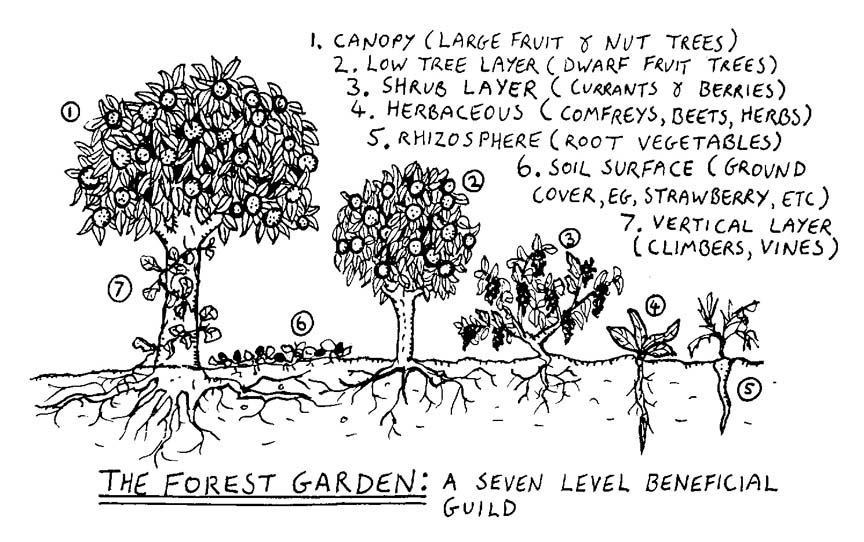|
The future is unwritten
Join Date: Oct 2002
Posts: 71,105
|
Apr 16th, 2017: Food Forest
What the hell, a drawing, a sketch in IOtD? Yup.
No matter, nobody’s going to see it anyway because they’re all busy with Easter, so kiss my keister.
There are different levels of we lazy bastards. Before I graduated to couch potato, then internet troll, I was wiling to expend
a great deal of energy to build something. But when it was done so was I. Maintenance? Boring, Fugetaboutit.
Probably that’s why this plan intrigued me.

Quote:
Canopy: This layer is primarily for large nut trees that require full sun throughout the day, such as pecans, walnuts,
and chestnuts, all of which mature to a height of 50 feet or more.
Understory Trees: This layer is for smaller nut trees, like filberts, and the majority of fruit trees. The most shade tolerant
fruit trees include native North American species like black mulberry, American persimmon and pawpaw, though many other
fruit trees will produce a respectable crop in partial shade.
Vines: Grapes, kiwis, and passion fruit are the most well-known edible vines, though there are many other more obscure
specimens to consider, some of which are quite shade tolerant, such as akebia (edible fruit), chayote (a perennial squash),
and groundnuts (perennial root crop). Kolomitka kiwi, a close relative of the fuzzy kiwis found in supermarkets, is among the
most shade-tolerant vines.
Shrubs: A large number of fruiting shrubs thrive in partial shade, including gooseberries, currants, serviceberries,
huckleberry, elderberry, aronia, and honeyberry, along with the “superfoods” sea berry and goji.
Herbaceous plants: This category includes not only plants commonly thought of as herbs—rosemary, thyme, oregano,
lavender, mint and sage are a few of the top perennial culinary herbs to consider for your forest garden—but is a catch-all
term for all leafy plants that go dormant below ground in winter and re-sprout from their roots in spring. This layer is where
perennial vegetables, like artichokes, rhubarb, asparagus and “tree collards” fit in.
Groundcovers: These are perennial plants that spread horizontally to colonize the ground plane. Edible examples include
alpine strawberries (a shade tolerant delicacy), sorrel (a French salad green), nasturtiums (has edible flowers and leaves),
and watercress (requires wet soil), all of which tolerate part shade.
Rhizosphere: This refers to root crops. It’s a bit misleading to call it a separate layer, since the top portion of a root crop
may be a vine, shrub, groundcover or herb, but it’s Hart’s way of reminding us to consider the food-producing potential
of every possible ecological niche. Most common root crops are sun-loving annuals, however so you’ll have to look to more
obscure species, such as the fabled Andean root vegetables oca, ulluco, yacon, and mashua, for shade-tolerant varieties.
|
I can see the appeal to critters too, so deer/rabbit/woodchuck proofing would be smart.
You can read the whole what to/how to at Modern Farmer.
CAUTION: creating this and eating the results, may make you healthy, so don’t forget to plant some Cheeto and M&M bushes.
__________________
The descent of man ~ Nixon, Friedman, Reagan, Trump.
|